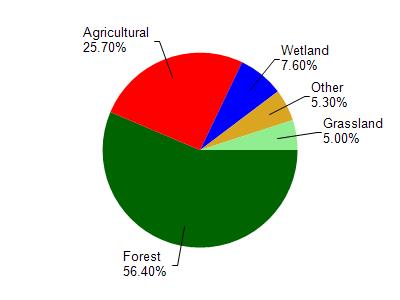Adams
No
No
No
Fish and Aquatic Life
Overview
Risk Creek is a Class II trout stream for the bottom 2.5 miles although it is thought that is has the potential to support a Class I fishery. Dam abandonment and removal at Brookside has improved fisheries and habitat of the stream. There is limited information available for this creek.
Date 2002
Author Cynthia Koperski
Historical Description
Risk Creek is a Class II trout stream (WDNR, 1980). Dam abandonment and removal at
Brookside has improved fisheries and habitat of the stream (WDNR, Ironside, 1991).
Date 1994
Author Surface Water Inventory Of Wisconsin
Historical Description
Risk Creek, T16N, R6E, Section 19 Surface Acres = 1.4, Miles = 1.6, Gradient = 17.5 feet per mile.
A short stream which flows westerly into Fairbanks Creek. A small, unnamed
flowage is located on the stream near its mouth at Brookside. At the time of the
investigation, a partially constructed pond was observed further upstream. The stream
has marsh drainage, but picks up more and more spring water as it nears the Brookside
pond. It is managed as a brook trout stream and there is natural reproduction.
That part of the stream from just above the pond at Brookside downstream to its mouth
had open water during the February, 1963, aerial groundwater survey. Mallard and
wood ducks reportedly nest along the stream. Several road crossings provide access.
From: Klick, Thomas A. and C.W. Threinen. 1966. Surface Water Resources of Adams County:
Lake and Stream Classification Project. Wisconsin Conservation Department, Madison, WI.
Date 1966
Author Surface Water Inventory Of Wisconsin
Condition
Wisconsin has over 84,000 miles of streams, 15,000 lakes and milllions of acres of wetlands. Assessing the condition of this vast amount of water is challenging. The state's water monitoring program uses a media-based, cross-program approach to analyze water condition. An updated monitoring strategy (2015-2020) is now available. Compliance with Clean Water Act fishable, swimmable standards are located in the Executive Summary of Water Condition in 2018. See also the 'monitoring and projects' tab.
Reports
Recommendations
Citizen-Based Stream Monitoring
Collect chemical, physical, and/or biological water quality data to assess the current overall stream health. The data can inform management decisions and may be used to identify impaired waters for biennial lists.
Citizen-Based Stream Monitoring
Collect chemical, physical, and/or biological water quality data to assess the current overall stream health. The data can inform management decisions and may be used to identify impaired waters for biennial lists.
Citizen-Based Stream Monitoring
Collect chemical, physical, and/or biological water quality data to assess the current overall stream health. The data can inform management decisions and may be used to identify impaired waters for biennial lists.
Monitor Fish Community
Risk Creek should be evaluated to determine if it is capable of supporting a Class I fishery. If so, habitat work should be conducted on the creek to improve the fishery.
Management Goals
Wisconsin's Water Quality Standards provide qualitative and quantitative goals for waters that are protective of Fishable, Swimmable conditions [Learn more]. Waters that do not meet water quality standards are considered impaired and restoration actions are planned and carried out until the water is once again fishable and swimmable
Management goals can include creation or implementation of a Total Maximum Daily Load analysis, a Nine Key Element Plan, or other restoration work, education and outreach and more. If specific recommendations exist for this water, they will be displayed below online.
Monitoring
Monitoring the condition of a river, stream, or lake includes gathering physical, chemical, biological, and habitat data. Comprehensive studies often gather all these parameters in great detail, while lighter assessment events will involve sampling physical, chemical and biological data such as macroinvertebrates. Aquatic macroinvertebrates and fish communities integrate watershed or catchment condition, providing great insight into overall ecosystem health. Chemical and habitat parameters tell researchers more about human induced problems including contaminated runoff, point source dischargers, or habitat issues that foster or limit the potential of aquatic communities to thrive in a given area. Wisconsin's Water Monitoring Strategy was recenty updated.
Grants and Management Projects
Monitoring Projects
| WBIC | Official Waterbody Name | Station ID | Station Name | Earliest Fieldwork Date | Latest Fieldwork Date | View Station | View Data |
|---|
| 1343900 | Risk Creek | 10030210 | Risk Creek at 9th Dr | 5/17/2009 | 8/23/2022 | Map | Data |
|

Watershed Characteristics
Risk Creek is located in the Duck and Plainville Creeks watershed which is 195.09 mi². Land use in the watershed is primarily forest (56.40%), agricultural (25.70%) and a mix of wetland (7.60%) and other uses (10.30%). This watershed has 218.59 stream miles, 339.26 lake acres and 9,551.62 wetland acres.
Nonpoint Source Characteristics
This watershed is ranked Low for runoff impacts on streams, Low for runoff impacts on lakes and High for runoff impacts on groundwater and therefore has an overall rank of High. This value can be used in ranking the watershed or individual waterbodies for grant funding under state and county programs.However, all waters are affected by diffuse pollutant sources regardless of initial water quality. Applications for specific runoff projects under state or county grant programs may be pursued. For more information, go to surface water program grants.